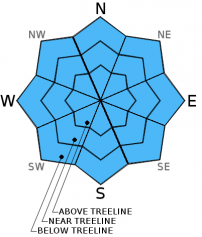| Thursday | Thursday Night | Friday | |
|---|---|---|---|
| Weather: | Partly cloudy with a slight chance of rain in the afternoon | Cloudy with a chance of rain | Rain |
| Temperatures: | 39 to 46 deg. F. | 32 to 37 deg. F. | 37 to 42 deg. F. |
| Mid Slope Winds: | Southwest | Southwest | Southwest |
| Wind Speed: | 10 to 20 mph with gusts to 30 mph | 15 to 25 mph with gusts to 40 mph | 25 to 35 mph with gusts to 65 mph |
| Expected snowfall: | 0 | Rain: .06 - .1 | Rain: .5-.75 |
| Thursday | Thursday Night | Friday | |
|---|---|---|---|
| Weather: | Partly cloudy with a slight chance of rain and snow in the afternoon | Cloudy with a chance of rain and snow | Rain and snow |
| Temperatures: | 35 to 42 deg. F. | 29 to 36 deg. F. | 30 to 37 deg. F. |
| Ridge Top Winds: | West to southwest | West to southwest | Southwest |
| Wind Speed: | 25 to 30 mph with gusts to 45 mph increasing to 30 to 45 mph with gusts to 65 mph in the afternoon | 40 to 45 mph with gusts to 70 mph increasing to 55 to 60 mph with gusts to 90 mph after midnight | 50 to 75 mph with gusts between 90 and 110 mph |
| Expected snowfall: | 0 | Rain: .06 - .1 in. | Snow: 0 to 1 | Rain: .5-.75 in. | Snow: 3 to 6 |





















